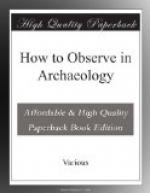Styles of flint work. The Eoliths are worn pebbles, chipped as if for scraping. The Rostro-carinate flints found at the base of the Crag are long bars with a beak-end, suited for breaking up earth. The human origin of both of these classes is contested. Flints of Strepy type are nodular and partly trimmed into cutting edges, the smooth surface being left as a handle. The Chelles types are remarkable for regularity and fine bold flaking; the worn butt (though best for handling) was eventually flaked away to obtain an artistic uniform finish. The St. Acheul series has finer flaking, the crust being completely removed: there is a tendency to ovate or almond shapes, and the edges are often curved, the reverse S-curve being preferred, They diminish in size towards the end of the period. The Chelles and St. Acheul series are core implements, made by detaching flakes; and the succeeding (Le Moustier) method is to use the flakes, generally for scraping. The la, Em the diagram is transitional from St. Acheul to Le Moustier. The form marked M is the predecessor of the Solutrean form next below it. The Aurignacian is a smaller flake industry, with many lumps more or less conical, and often with careful parallel flaking or fluting. The Solutre culture brought in a new style, particularly thin blades with delicate surface flaking which seems to have reappeared in the late Neolithic. The pointed borers, certain arrow-heads and minutely chipped rods of flint are characteristic of the period, and flints of this age are found on the Egyptian and Syrian deserts. Longer blades, sometimes very coarse, with ends worn by scraping, mark the period of La Madeleine. They are found in prehistoric Egyptian graves, along with Neolithic knives and lances. As a technical advance on flaking by blows or pressure, grinding and incidental polishing of flint implements are regarded as characteristic of the Neolithic period; and the practice may have started in areas devoid of flint, where it was necessary to utilize local material that could not be flaked like flint. In Europe generally, polished celts belong to the Megalithic or latest division of the Neolithic, but this implement appeared much earlier, and in a sense succeeded the Palaeolithic hand-axe. The latter is not known to have been hafted, and its working edges were at the pointed end; whereas in Neolithic times the implement had become an axe in the modern sense, with the pointed end inserted in a haft, and the cutting edge removed to the broader end. There are many other Neolithic types, used with or without a haft, and only a small proportion were finished by grinding on sandstone.
CHAPTER II
GREECE
[See the diagrams of flint implements, [Illustration ii] of pottery, [Illustration III]; and of alphabets, [Illustration IV]]




